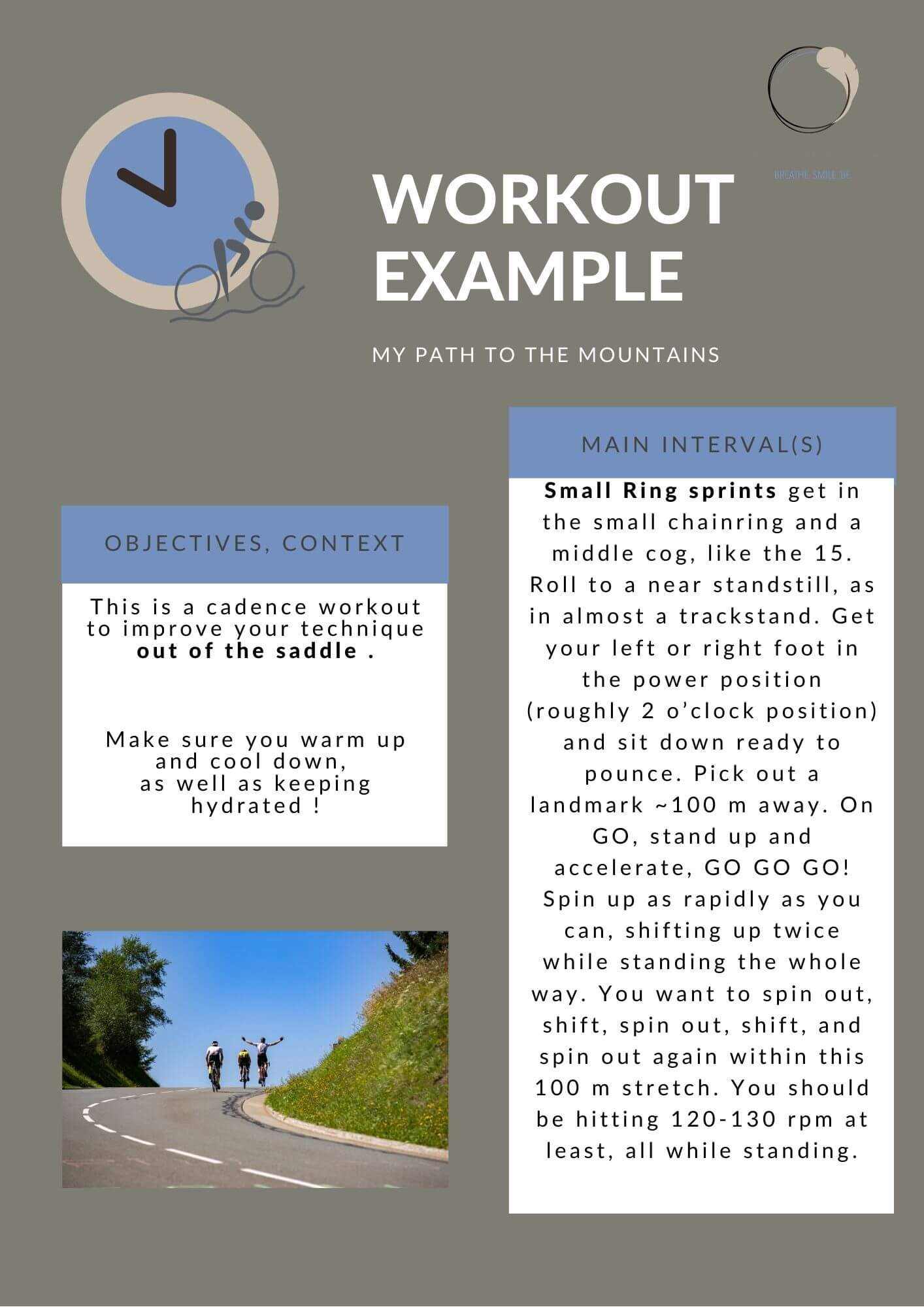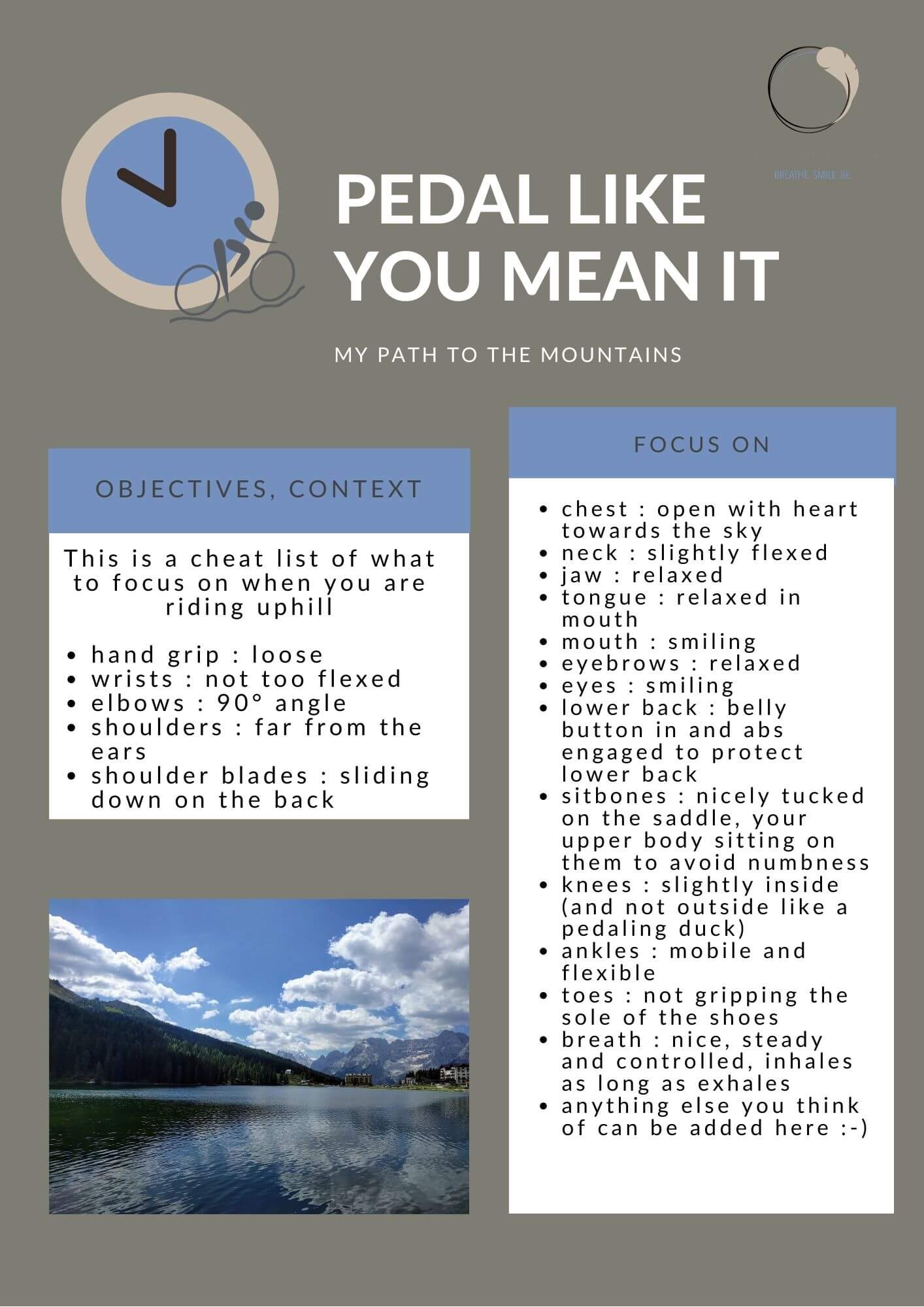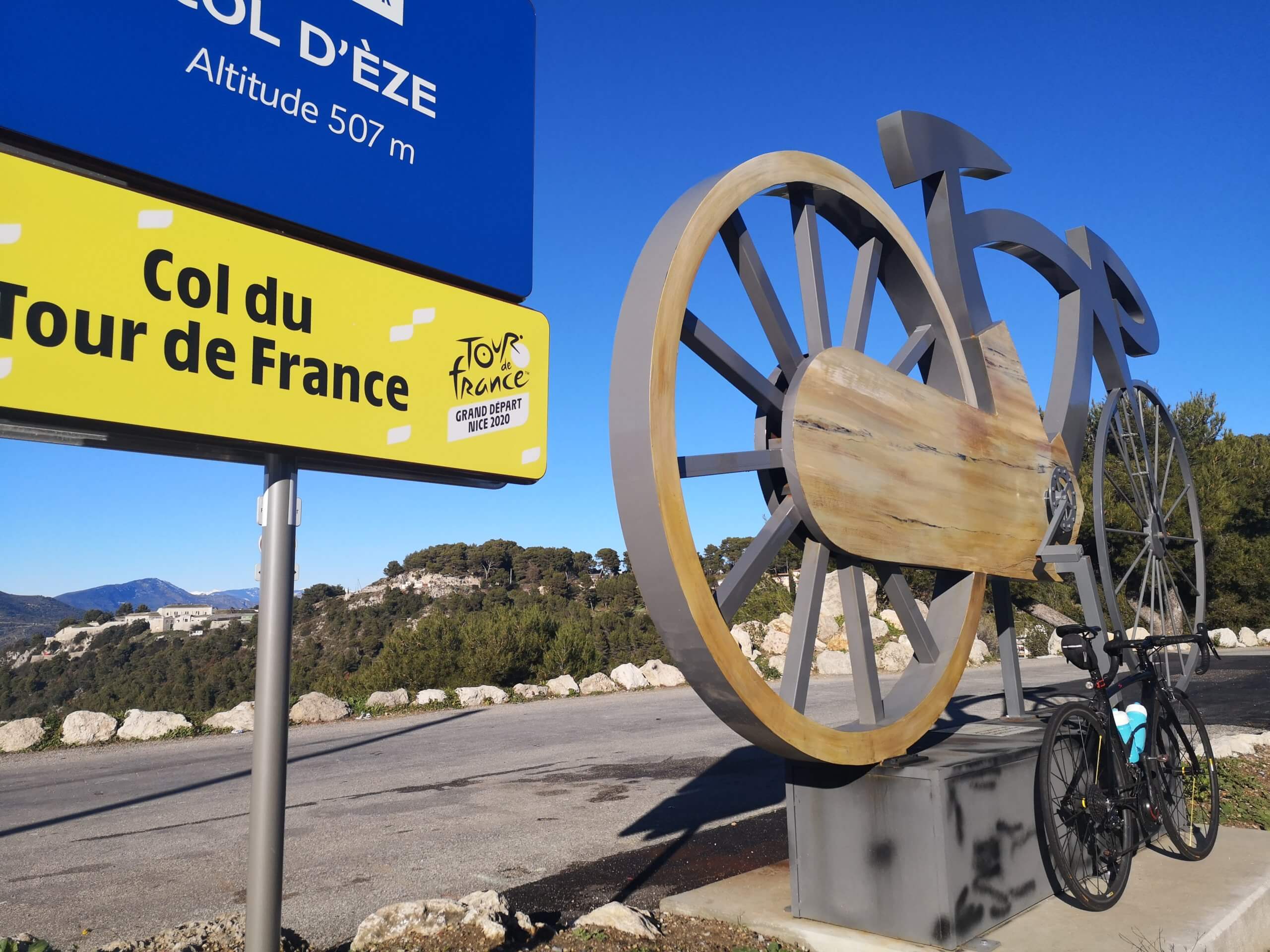S’entraîner pour faire du vélo en montagne… A l’heure où Noël approche et certains pays voient une amélioration de la situation sanitaire, nous commençons tous à préparer la prochaine étape et à rêver aux montagnes, soit parce que nous les voyons de loin se couvrir d’une fine couche de neige, soit parce que l’on pense au ski ou (encore mieux !) à explorer les montagnes sur nos vélos. Comme vous le savez, je suis profondément convaincue de l’avantage d’utiliser un capteur de puissance : il est l’un de vos alliés le plus précieux pour l’entraînement et la meilleure expérience en montagne !
Gérer votre effort pour grimper à vélo
La façon de gérer votre effort est LE paramètre le plus important qui vous permettra de rouler en montagne et d’apprécier le voyage ! Et seul un capteur de puissance pourra vous permettre de connaître et tenir cet effort. En effet, qui n’a pas senti des ailes lui pousser dans le dos lors des premiers kilomètres d’un long col, et, petit à petit ces ailes ont fondu et on arrive en haut à la vitesse d’un escargot. Pour comprendre comment cela peut arriver, il suffit de revenir à la définition de la puissance seuil (Functional Threshold Power, FTP) qui est la puissance au-delà de laquelle la fatigue arrive bien plus rapidement. On ne pourra rouler à des puissances supérieure à la FTP que pour quelques dizaines de minutes tout au plus, tandis que nous pouvons passer plusieurs heures à rouler en-dessous de sa FTP. Il est donc de la plus haute importance de bien comprendre qu’il ne sert à rien de commencer à grimper un col avec une puissance supérieure à sa FTP, à rien ! Et il faut donc utiliser votre capteur de puissance pour prendre ce rythme et s’y tenir jusqu’au sommet.
Nous avons tendance à prendre un rythme basé sur notre perception de l’effort. Cependant, nos ressentis ne sont pas proportionnels à la réalité de notre effort : la même puissance pourra nous sembler « facile » au début d’une séance, et incroyablement difficile à la fin d’une autre ! On voit donc deux aspects de la gestion de l’effort transparaître ici : le premier est la capacité à choisir une puissance qui est en-dessous de votre seuil, typiquement votre sweet-spot (juste en-dessous de votre seuil, ou bien dans la zone haute tempo, à 88%-93% de votre FTP), le second aspect est d’apprendre à conserver un effort / une puissance constant(e).
Des variations de puissance de l’ordre de 10% ou 20% ne font pas apparaître de fatigue neuromusculaire prématurée par rapport à un effort à puissance constante comme l’a montré cette étude. Cependant, tout cycliste ayant couru quelques critériums pourra témoigner de la difficulté à résister à la fatigue lorsque l’on ne fait qu’alterner entre des puissances bien au-dessus de la puissance seuil (typiquement dans la zone de capacité anaérobie) et des puissances en-dessous du seuil, comme par exemple avant et après un virage. Les grandes variations de puissance semblent donc fatiguer le corps plus rapidement, et il est donc important de conserver un rythme assez constant dans un col, sans pousser plus qu’il n’en faut dans les parties les plus pentues. C’est là que le capteur de puissance est extrêmement utile, pour mesurer en temps réel l’effort fourni et limiter les variations de puissance trop importantes.
Exemple de session
Vous pouvez vous entraîner à gérer vos efforts à n’importe quelle puissance. Pour commencer, je vous conseille de conserver une puissance constante lors d’une sortie à endurance basse (entre 56% et 65% de votre FTP) : roulez et observez simplement comment votre puissance varie (en regardant la puissance moyennée sur 3 secondes vous pourrez faire vos observations plus facilement), cela vous permettra de réaliser que lorsque la pente monte vous n’avez pas besoin de rajouter trop de puissance, mais que sur le plat ou en descente il vous faudra pédaler pour maintenir une puissance constante ! Une fois que vous maîtrisez cette capacité à garder un effort constant, augmentez la puissance de l’effort et prenez plaisir à explorer les diverses sensations qui viennent en maintenant différentes puissances sur différentes durées.
S’entraîner au sweet spot…
As explained above, sweet spot is going to be your best friend uphill ! The higher your FTP, the faster you will go uphill of course, and if you have a high power to weight ratio (meaning a high FTP coupled with a light weight), you’ll go even faster. I’m not saying that power to weight is the only thing you need to aim at if you want to be able to ride in the mountains, basically you need to focus on your FTP as this will be your top end power output in long climbs, and if you eat a balanced diet, there shouldn’t be any need to stress about carrying too much weight uphill, except if you are racing and aiming at being the fastest (but if that was the case I would imagine you’d have a proper coach and nutritionist already with you and wouldn’t be reading this page !).
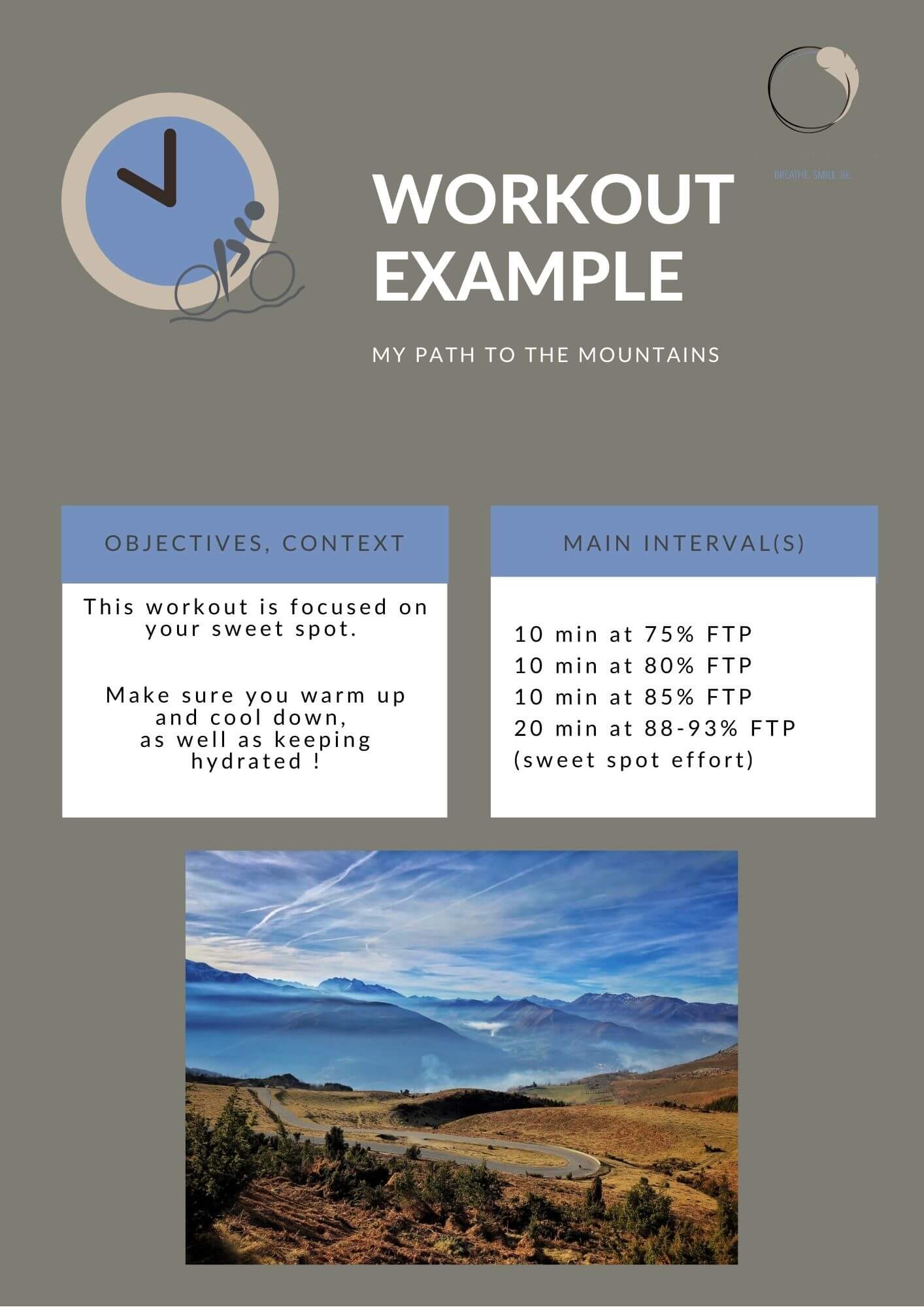 Sweet spot will then also be an amazing friend in your training : in this zone, the workouts have the abilities to increase your FTP by inducing the following adaptations more than if you were riding in another power zone : increased plasma volume, increased muscle mitochondrial enzymes, increased lactate threshold (data from Training and Racing with a power meter). Spending more and more time at sweet spot will allow you to get used to your mountain pace and will contribute to increasing your FTP.
Sweet spot will then also be an amazing friend in your training : in this zone, the workouts have the abilities to increase your FTP by inducing the following adaptations more than if you were riding in another power zone : increased plasma volume, increased muscle mitochondrial enzymes, increased lactate threshold (data from Training and Racing with a power meter). Spending more and more time at sweet spot will allow you to get used to your mountain pace and will contribute to increasing your FTP.
Workouts example
There are so many ways to enjoy good training around your sweet spot ! Start with including 2 times 10 minutes at 88-93% FTP at 90-100rpm in your rides, increasing the time from one workout to the next (to 15 minutes, then 20 minutes). Then add some tempo work after your sweet spot intervals, at 75-80% FTP. One of my favourite sweet spot training is a power ramp which challenges your aerobic endurance and your fatigue resistance !
… avec quelques intensités en plus !
Your FTP isn’t your everything on the bike. You do need to work on your VO2max or MAP (Maximal Aerobic Power) if you want to increase your FTP. The VO2max could be described as the roof of your own power house, and your FTP as the ceiling. If the roof is too low, your FTP will not be able to get any higher. The VO2max efforts, by pushing your body to its aerobic limit, will also allow you to get acquainted to this feeling and it will mentally help you manage the threshold efforts better.
It is also extremely important to work here and there on your anaerobic capacity, your ability to manage efforts from 30 seconds to 2 minutes. Indeed, these are the efforts you will need to produce if there is a steep part in your climb, and when the slope reaches two digits, it becomes quite hard to keep a pace under threshold ! So you will need to spend some time here and there playing around with these feelings so that you are fully ready for the mountains.
Exemple de session
I would suggest adding some VO2max (3 to 8 minutes all-out) efforts in your training, once a week during your winter foundation training, more often in the late spring (up to once a week, depending on how your body react to these trainings). Fr-or highly trained athletes, a VO2max training block can also be interesting (with 2 to 3 VO2max workouts a week) two months prior to the event you are training for.
As regards to anaerobic capacity, you can include some 1 minute all-out intervals here and there once a month during your winter preparation, and in late spring add an anaerobic workout every other week when you are fresh, but not more than this is the mountains are your only goal.
Technique de pédalage pour la montagne
Pédaler en continu
From now on, the tips are non related to using your power meter ! One of the main differences between riding a climb and being on the flat is that you have absolutely zero moment of rest, you are constantly turning your legs. On your usual rides, I guess there are always some little moments when you can free-wheel, stand up on the pedals and stretch the legs or just stop spinning. Uphill is not the best place to do that, unless you are happy to roll a few meters backwards so that you can climb some more !
Exemple de session
Notice when you stop spinning the legs during your rides : is it in the descents ? on speed bumps ? when you are in the wheels of your riding buddies ? when you start feeling tired ? Whatever the moment is, you have to first become aware you stopped turning your legs, and then it’s all about keeping the rotations per minute on : you can keep pedalling when you go over speed bumps, you can keep pedalling in the descents ! The fatigue from this constant spinning is real so you have to train your ability to maintain a constant spin.
Un coup de pédale efficace
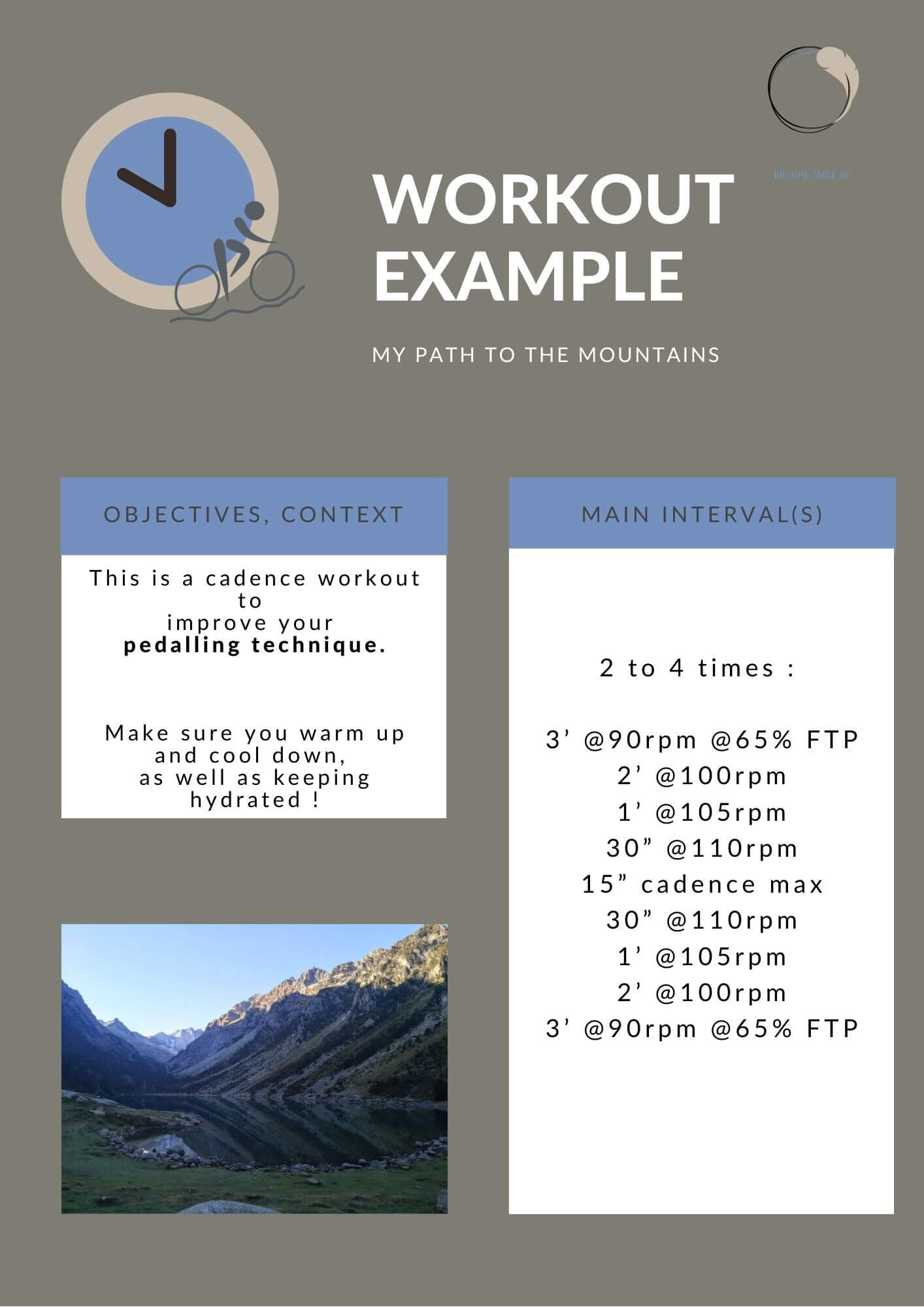 Along with the previous observation, having an efficient and effective pedal stroke is important to keep you spinning smoothly. That means being able to not only push but also pull on the pedals, so that the effort doesn’t rely only on the prime movers (glutes and quadriceps). That also means you don’t want any parasite movements as you want all your energy to go to the unique goal of powering you uphill : no knee wobbling, no rocking on your saddle, no dancing with your shoulders. First things first, a proper bike fit will allow you to fully trust that your position is suitable for your body on your bike. From there, a good way to improve your pedal stroke is to push this skill to its limit (meaning high cadences) so that you can feel if there are any dead spot or lack of coordination.
Along with the previous observation, having an efficient and effective pedal stroke is important to keep you spinning smoothly. That means being able to not only push but also pull on the pedals, so that the effort doesn’t rely only on the prime movers (glutes and quadriceps). That also means you don’t want any parasite movements as you want all your energy to go to the unique goal of powering you uphill : no knee wobbling, no rocking on your saddle, no dancing with your shoulders. First things first, a proper bike fit will allow you to fully trust that your position is suitable for your body on your bike. From there, a good way to improve your pedal stroke is to push this skill to its limit (meaning high cadences) so that you can feel if there are any dead spot or lack of coordination.
Exemple de session
I love cadence pyramids, they are great ways to train your pedal stroke and to make long endurance rides go faster ! Here is an example of what to do (adapt the cadence indications to your current abilities)
Another lovely workout is to include single legged bouts of 30 seconds to 1 minute during your warm up, recovery or cool down. You might look a bit funny but these drills (one leg clipped in, the other one unclipped) will teach you a lot.
En danseuse
Riding out of the saddle is not « natural », it uses different muscles than riding in the saddle. When thinking about climbing, riding out of the saddle is going to be your « recovery » moment. It can also be your attacks of course ! It can be a recovery moment if your body is used to riding out of the saddle, so that just by using different muscles, your other muscles get a chance to breath and relax a bit, which will help tackling your fatigue from repetitive movements. Riding uphill, you can simply get into the pace of riding out of the saddle for a few seconds every other minute.
Exemple de session
To improve your ability to ride out of the saddle, you can work on two aspects : the technique, and then the duration you spend out of the saddle. To improve your technique, two kind of skills are useful :
- riding out of the saddle at high cadences, such as when doing small ring sprints,
- or riding out of the saddle at very low cadence, such as when you do low-cadence high-torque intervals, really trying to use your arms to balance the handlebars from left to right.
Haut du corps décontracté
Who’s feeling tight shoulders or neck after a strenuous effort on the bike ? Good news is : you don’t need to be in pain there to enjoy the mountains ! Relaxing your upper body is important as it allows you to keep your energy to power up the hill, and to avoid useless pains and discomfort. There is a fine balance between keeping your back straight and core engaged and not adding any more tension to it.
Think about riding with your shoulders far from your ears , and your chest opened as if you were a Baywatch hero !
Un corps gainé
A strong core is incredibly important : it will not push you uphill faster, yes, but it will allow you to ride longer and pain free, it will allow you to avoid this lower back pain you often feel. Gift yourself with a core session 2 to 3 times a week, it doesn’t need to be more than 20 minutes long and it will make a huge difference on the long run and in your bike handling skills.
Le livre que je trouve le plus pertinent et facile à utiliser pour ce travail est Tom Danielson’s Core Advantage !
Des muscles forts
Improving your leg muscles force is another essential aspect of the improvement of your functional threshold. Force is something you can train on the bike doing low-cadence drills : I couldn’t find research studies showing how low-cadence drills would increase your force. To show you the difficulty to find an answer to this question : one study showed that these drills would increase the power output at lactate threshold for untrained male cyclists, when another one showed that it wouldn’t improve cycling performance for veteran cyclists. When building force or strength, the protein intake is as important as the training stimulus and these parameters were not take into account in the aforementioned studies.
Thus, there is no proper study (yet) showing the effectiveness of low cadence drills on the bike to build strength. If you decide on using them, be mindful to go for them in a progressive way, increasing gently the time spent at low cadence to preserve the integrity of your tendons, and decreasing the cadence bit by bit.
In the gym, you have to go for heavy weights especially if you are a male over 40, or a female over 25 (which are the approximate age when muscles start declining and need external stimulation to be maintained). For female riders with natural menstrual cycles, use your follicular phase to build muscles, and the luteal phase to work on your plyometrics. For women in menopause, the lack of estrogen and its anabolic effects leads to changes in your training: you need to incorporate more heavy lifting and plyometrics as well as more protein intake to stimulate muscle protein synthesis (to maintain and build lean muscle mass, keep a healthy body composition and limit the risks of sarcopenia). A good way to do that would be to slightly reduce your volume on the bike and add some more gym time (for instance doing 20 minutes of heavy lifting before going riding).
Et de nombreux autres détails !
Hydratation & Nutrition
The mountains will ask you to put your best self forward, and for that you need to be hydrated and fueled enough ! Hydration is in your bottle (try out 1/2 lemon juice, salt and 1 tbsp of maple syrup in your 500 mL water bidon), and fuel is in your pocket. The same advices as for any kind of ride applies, except that you might want to train yourself to eat while making threshold efforts so that you become more used to chewing some food and powering up on the pedals at the same time.
Préparation mentale
Your mental preparation is of course of the utmost importance. I have already explained why mental training is so important, and the mountains are no exceptions. There are two aspects which make them mentally challenging : the length of the efforts and the stress of descending for those not feeling comfortable with it. To prepare for the duration of the efforts, you need to improve your focus, your ability to direct your attention to one thing at a time for 20 minutes to 2 hours. Try to disconnect from phone and emails and to work only on one thing at work, you will see that it is not as easy as it seems !
To manage the stress of the descents, I would advise learning some breathing techniques to relax (learning to exhale longer than you inhale) and to use visualisation to prepare for the descents. Start by watching many videos of descending cyclists (road and mountain bike), look at their positions on the bike and where they look, and then visualise yourself (with eyes closed, why not while spinning your legs on your turbo trainer) going downhill in a smooth and happy way.
Votre regard
Your stem might be made out of diamond, you need to learn to detach from looking at it during the efforts ! Our gaze is a huge part of our concentration, , and where focus goes, energy flows : if you look ‘down’ on your stem, you will not go ‘up’. Looking up towards where you are going will drive your body towards this unique goal :riding up.
In yoga, the gaze is an important part of the asana (movements) practice, it is called drishti in Sanskrit. Drishti doesn’t only means gaze, it also means vision, a point of view, opinion, wisdom, attitude. Look up like you mean it, believe that you are riding up; sometimes, just the courage of looking up will make the effort feel less painful, because you just evolved from sustaining a hard effort to envisioning a goal.
Exemple de session
Well, the first step is (again !) to become conscious that you are looking at your stem sometimes. Each time you ride, indoors or outdoors, be mindful of it. And bit by bit you will realise your gaze gets out of your control, and then simply bring it back to looking up and forward.
I know, that makes the list of everything you need to focus on quite long ! These many things to think about will help you keep your mind focused. Concentration is a trainable skill, so don’t wait until you are at the bottom of the climb to start thinking about all these details. I would suggest you write them all down and stick them on your top tube or on the wall of your turbo-trainer pain cave.
For more training ideas, look at our pre-built training plans !

